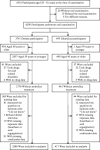Self-reported halitosis and gastro-esophageal reflux disease in the general population
- PMID: 18196351
- PMCID: PMC2359469
- DOI: 10.1007/s11606-007-0486-8
Self-reported halitosis and gastro-esophageal reflux disease in the general population
Abstract
Background: Patients with halitosis contact primary care practitioners, dentists, and gastroenterologists alike.
Objectives: It is unclear whether gastroesophageal reflux disease (GERD) is a risk factor for halitosis. DESIGN AND PATIENTS/PARTICIPANTS: We studied this possible relationship in the general population using the cross-sectional Study of Health in Pomerania (SHIP). Employing structured interviews, self-reported halitosis was assessed among 417 edentulous (toothless) subjects aged 40 to 81 years and among 2,588 dentate subjects aged 20 to 59 years. The presence of heartburn or acid regurgitation (GERD-related symptoms) at 4 levels (absent, mild, moderate, severe) was taken as exposure and used for logistic regression. Analyses were adjusted for relevant confounders, such as age, sex, depressive symptoms, history of chronic gastritis, history of gastric or duodenal ulcer, smoking, school education, and dental status.
Measurements and main results: We found a strong positive association between GERD-related symptoms and halitosis (odds ratio 12.94, 95% confidence interval (CI) 2.66-63.09, P = 0.002 for severe compared to no GERD-related symptoms) in denture-wearing subjects and a moderate, positive association between GERD-related symptoms and halitosis (odds ratio 2.24, 95% CI 1.27-3.92, P = 0.005) in dentate subjects with a clear dose-effect relationship.
Conclusions: The present study provides clear evidence for an association between GERD and halitosis. As there are effective treatments for GERD, these results suggest treatment options, such as proton pump inhibitors, for halitosis. These should be studied in randomized controlled trials.
Figures
References
-
- {'text': '', 'ref_index': 1, 'ids': [{'type': 'PubMed', 'value': '7560419', 'is_inner': True, 'url': 'https://pubmed.ncbi.nlm.nih.gov/7560419/'}]}
- Rosenberg M, Kozlovsky A, Gelernter I, et al. Self-estimation of oral malodor. J Dent Res. 1995;74:1577–82. - PubMed
-
- None
- Delanghe G, Ghyselen L, Feenstra L, van Steenberghe D. Experiences of a Belgian multidisciplinary breath odour clinic. In: van Steenberghe D, Rosenberg M, eds. Bad Breath. A Multidisciplinary Approach. Leuven: Leuven University Press; 1996:199–208.
-
- {'text': '', 'ref_index': 1, 'ids': [{'type': 'PubMed', 'value': '9086681', 'is_inner': True, 'url': 'https://pubmed.ncbi.nlm.nih.gov/9086681/'}]}
- Bosy A. Oral malodor: philosophical and practical aspects. J Can Dent Assoc. 1997;63:196–201. - PubMed
-
- None
- Miyazaki H, Fujita C, Soh I, Takehara T. Relationship between volatile sulphur compounds and oral conditions in the general Japanese population. In: van Steenberghe D, Rosenberg M, eds. Bad Breath. A Multidisciplinary Approach. Leuven: Leuven University Press, 1996.
-
- {'text': '', 'ref_index': 1, 'ids': [{'type': 'DOI', 'value': '10.1016/j.jdent.2005.10.002', 'is_inner': False, 'url': 'https://doi.org/10.1016/j.jdent.2005.10.002'}, {'type': 'PubMed', 'value': '16309815', 'is_inner': True, 'url': 'https://pubmed.ncbi.nlm.nih.gov/16309815/'}]}
- Al-Ansari JM, Boodai H, Al-Sumait N, Al-Khabbaz AK, Al-Shammari KF, Salako N. Factors associated with self-reported halitosis in Kuwaiti patients. J Dent. 2006;34:444–9. - PubMed
Publication types
MeSH terms
LinkOut - more resources
Full Text Sources
Medical
Research Materials


